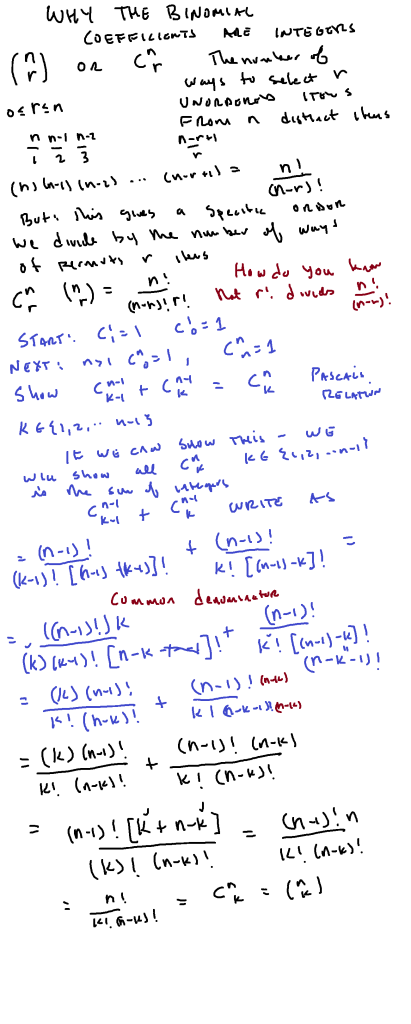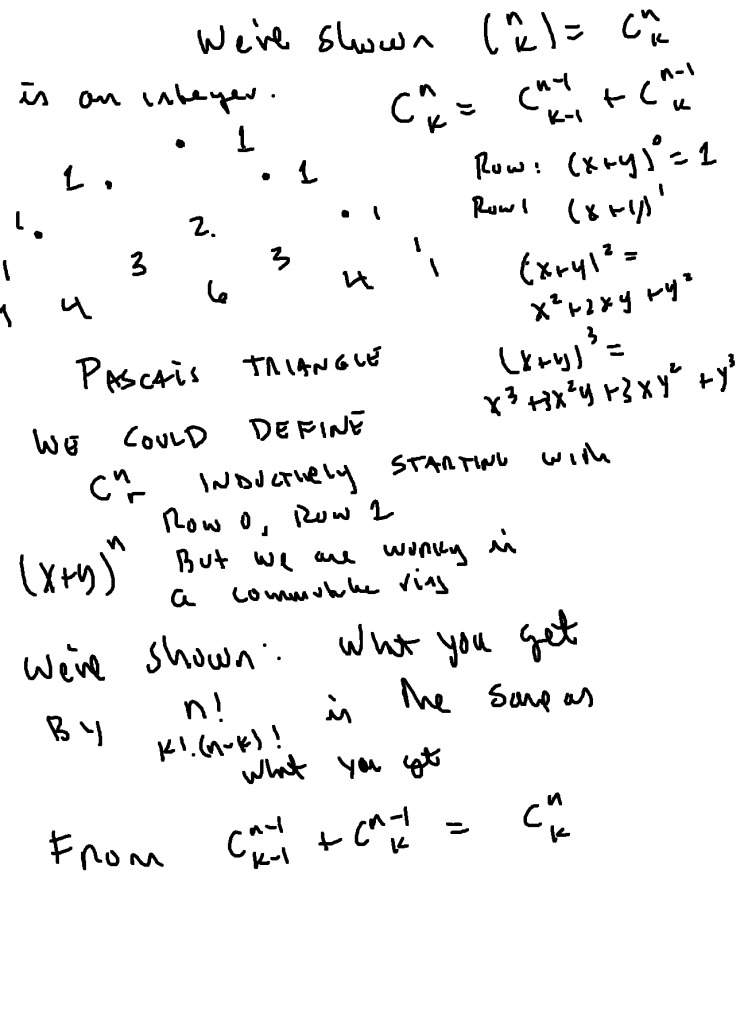The video, when ready, will be posted below.


I talked about the root and ratio test here and how the root test is the stronger of the two tests. What I should point out that the proof of the root test depends on the basic comparison test.
And so..a professor on Twitter asked:
Of course, one proves the limit comparison test by the direct comparison test. But in a calculus course, the limit comparison test might appear to be more readily useful..example:
Show converges.
So..what about the direct comparison test?
As someone pointed out: the direct comparison can work very well when you don’t know much about the matrix.
One example can be found when one shows that the matrix exponential where
is a
matrix.
For those unfamiliar: where the powers make sense as
is square and we merely add the corresponding matrix entries.
What enables convergence is the factorial in the denominators of the individual terms; the i-j’th element of each can get only so large.
But how does one prove convergence?
The usual way is to dive into matrix norms; one that works well is (just sum up the absolute value of the elements (the Taxi cab norm or
norm )
Then one can show and
and together this implies the following:
For any index where
is the i-j’th element of
we have:
It then follows that . Therefore every series that determines an entry of the matrix
is an absolutely convergent series by direct comparison. and is therefore a convergent series.
Let’s look at an “easy” starting example: write
We know how that goes: multiply both sides by to get
and then since this must be true for ALL
, substitute
to get
and then substitute
to get
. Easy-peasy.
BUT…why CAN you do such a substitution since the original domain excludes ?? (and no, I don’t want to hear about residues and “poles of order 1”; this is calculus 2. )
Lets start with with the restricted domain, say
Now multiply both sides by and note that, with the restricted domain
we have:
But both sides are equal on the domain
and the limit on the left hand side is
So the right hand side has a limit which exists and is equal to
. So the result follows..and this works for the calculation for B as well.
Yes, no engineer will care about this. But THIS is the reason we can substitute the non-domain points.
As an aside: if you are trying to solve something like one can do the denominator clearing, and, as appropriate substitute
and compare real and imaginary parts ..and yes, now you can use poles and residues.
We are using Mathematical Statistics with Applications (7’th Ed.) by Wackerly, Mendenhall and Scheaffer for our calculus based probability and statistics course.
They present the following Theorem (5.5 in this edition)
Let and
have a joint density
that is positive if and only if
and
for constants
and
otherwise. Then $Y_1, Y_2 $ are independent random variables if and only if
where
are non-negative functions of
alone (respectively).
Ok, that is fine as it goes, but then they apply the above theorem to the joint density function: for
and 0 otherwise. Do you see the problem? Technically speaking, the theorem doesn’t apply as
is NOT positive if and only if
is in some closed rectangle.
It isn’t that hard to fix, I don’t think.
Now there is the density function on
and zero elsewhere. Here,
are not independent.
But how does one KNOW that ?
I played around a bit and came up with the following:
Statement: (note: assume
Proof of the statement: substitute into both sides to obtain
Now none of the
else function equality would be impossible. The same argument shows that
with none of the
.
Now substitute into both sides and get
but no factor on the right hand side can be zero.
This is hardly profound but I admit that I’ve been negligent in pointing this out to classes.
We are discussing abstract vector spaces in linear algebra class. So, I decided to do an application.
Let denote the polynomials of degree
or less; the coefficients will be real numbers. Clearly
is
dimensional and
constitutes a basis.
Now there are many reasons why we might want to find a degree polynomial that takes on certain values for certain values of
. So, choose
. So, let’s construct an alternate basis as follows:
This is a blizzard of subscripts but the idea is pretty simple. Note that and
if
.
But let’s look at a simple example: suppose we want to form a new basis for and we are interested in fixing
values of
.
So
. Then we note that
Now, we claim that the are linearly independent. This is why:
Suppose as a vector. We can now solve for the
Substitute
into the right hand side of the equation to get
(note:
for
). So
are
linearly independent vectors in
and therefore constitute a basis.
Example: suppose we want to have a degree two polynomial where
. We use our new basis to obtain:
. It is easy to check that
We had a fun mathematics seminar yesterday.
Andrew Shallue gave a talk about the Carmichael numbers and gave a glimpse into his research. Along the way he mentioned the work of another mathematician…one that I met during my ultramarathon/marathon walking adventures! Talk about a small world..
So, to kick start my brain cells, I’ll say a few words about these.
First of all, prime numbers are very important in encryption schemes and it is a great benefit to be able to find them. However, for very large numbers, it can be difficult to determine whether a number is prime or not.
So one can take short cuts in determining whether a number is *likely* prime or not: one can say “ok, prime numbers have property P and if this number doesn’t have property P, it is not a prime. But if it DOES have property P, we hare X percent sure that it really is a prime.
If this said property is relatively “easy” to implement (via a computer), we might be able to live with the small amount of errors that our test generates.
One such test is to see if this given number satisfies “Fermat’s Little Theorem” which is as follows:
Let be a positive integer and
be a prime, and suppose
, that is
Then
If you forgotten how this works, recall that is a field if
is a prime, so
means that the set
consists of
. So take the product
. Now note that we are working in a field, so we can cancel the
factor on both sides to get
.
So one way to check to see if a number might be a prime is to check all
for all
and see if
.
Now this is NOT a perfect check; there are non-prime numbers for which for all
; these are called the Carmichael numbers. The 3 smallest such numbers are 561, 41041 and 825265.
The talk was about much more than this, but this was interesting.
The mainstream media recently had some excellent articles on two mathematical giants:
John Conway and Terrance Tao. I’ve never met Terry Tao though I do read (or try to follow) his blog.
I did meet John Conway when he visited the University of Texas. He is a friend of my dissertation advisor and gave some talks on knot diagram colorings.
I had a private conversation with him at a party, and he gave me some ideas which resulted in three papers for me! Here is one of them.
Yes, I am avoiding studying a book on the theory of interest; I am teaching that course this fall and need to get ahead of the game.
Unfortunately, when I don’t teach, my use of time becomes undisciplined.
For those of you who are a bit rusty: a finite group is a group that has a finite number of elements. A simple group is one that has no proper non-trivial normal subgroups (that is, only the identity and the whole group are normal subgroups).
It is a theorem that if is a finite simple group then
falls into one of the following categories:
1. Cyclic (of prime order, of course)
2. Alternating (and not isomorphic to of course)
3. A member of a subclass of Lie Groups
4. One of 26 other groups that don’t fall into 1, 2 or 3.
Scientific American has a nice article about this theorem and the effort to get it written down and understood; the problem is that the proof of such a theorem is far from simple; it spans literally hundreds of research articles and would take thousands of pages to be complete. And, those who have an understanding of this result are aging and won’t be with us forever.
Here is a link to the preview of the article; if you don’t subscribe to SA it is probably in your library.
If you teach at an institution that has a competitive sports team, you’ll probably notice that the coaches spend time on recruiting. It is easy to see why: though athletes train hard to improve their performances, their inherent athletic ability provides an upper bound of how well they will do.
I played sports in high school, but wasn’t within an AU of being able to compete at the college level, any division. I remember summer wrestling; those recruited to wrestle for our team basically had their way with me on the mat.
In my current sports, I always do poorly in competition. For example, in my best running marathon, the winner beat me by 74 minutes! (winning time was 2:19).
It wasn’t that I didn’t try or didn’t train: it was that because I am a poor natural athlete, training only “moves the needle” just a bit, and not nearly enough for me to be competitive.
A coach could give me this workout or that workout…and get angry with me. But I have athletic limitations.
The same principle applies in mathematics.
Right now I am teaching the second semester of calculus for non-technical majors.
One question was: find the maximum and minimum of . They were told that this function modeled daily temperature where
was in days,
on January 1.
Now I asked the class some questions. And, well, let’s just say that they didn’t just recognize what the various terms and factors meant.
Now we took the derivative to find the local maximum and local minimum values and most of them got . Now we set this equal to zero and all of them that we got zero when the argument was 0 or an integral multiple of
.
But now, when we had I said “of course, this gives us the solution
. And you guessed it…one of the students asked “why”. It took about a minute of explanation for her to see it. I kid you not.
So, I reminded myself of what it must have been like for my sports coaches in high school…..what it was like for them to work with me.
For the prize: what is the significance of the two chains, and which one directly applies to the human subject of this doodle?
The human subject of the doodle is Emmy Noether.